Sony J8270, J9210, J8210 User Manual

User guide
Xperia 5
J8210/J8270/J9210
Contents |
|
Software update features............................................................ |
5 |
Changes after updating the software to Android 10...................... |
5 |
Xperia 5 features.......................................................................... |
7 |
Cinema Pro....................................................................................... |
7 |
Game enhancer............................................................................... |
8 |
Enhancing the sound output.......................................................... |
9 |
Side sense........................................................................................ |
9 |
Dynamic Vibration.......................................................................... |
12 |
Ambient display settings............................................................... |
12 |
Smart call handling........................................................................ |
13 |
Getting started............................................................................ |
15 |
About this User guide.................................................................... |
15 |
Overview........................................................................................ |
16 |
Assembly - Single SIM.................................................................... |
17 |
Assembly - Dual SIM...................................................................... |
18 |
Using a Dual SIM device................................................................. |
19 |
Screen protection........................................................................... |
19 |
Starting your device for the first time........................................... |
20 |
Why do I need a Google account?................................................ |
20 |
Transferring content from your old device................................... |
20 |
Device security........................................................................... |
22 |
Making sure your device is protected........................................... |
22 |
Screen lock..................................................................................... |
22 |
Fingerprint Manager ..................................................................... |
23 |
SIM card protection........................................................................ |
23 |
Finding the IMEI number(s) of your device................................... |
24 |
Finding, locking or erasing a lost device ...................................... |
24 |
Learning the basics.................................................................... |
26 |
Using the touchscreen................................................................... |
26 |
Turning the screen on or off.......................................................... |
27 |
Smart backlight control................................................................. |
28 |
Home screen.................................................................................. |
28 |
Application screen......................................................................... |
28 |
Navigating applications................................................................. |
29 |
Widgets.......................................................................................... |
32 |
Shortcuts and folders.................................................................... |
32 |
Background.................................................................................... |
33 |
Taking a screenshot....................................................................... |
34 |
Notific tions................................................................................... |
34 |
2
Icons in the status bar................................................................... |
36 |
Battery and maintenance.......................................................... |
38 |
Charging your device..................................................................... |
38 |
Battery and power management................................................. |
40 |
Updating your device..................................................................... |
41 |
Restarting, resetting and repairing............................................... |
42 |
Improving memory performance................................................. |
44 |
Backing up and synchronizing data.......................................... |
46 |
Backing up and synchronizing with a Google account ............... |
46 |
Backing up and transferring data using a computer.................... |
47 |
Backing up and transferring data using a memory card.............. |
47 |
Downloading applications......................................................... |
48 |
Downloading applications on Google Play.................................. |
48 |
Internet and networks................................................................ |
49 |
Mobile data connection................................................................ |
49 |
Wi-Fi............................................................................................... |
49 |
Sharing your mobile data connection.......................................... |
50 |
Controlling data usage.................................................................. |
50 |
Basic settings.............................................................................. |
52 |
Accessing settings......................................................................... |
52 |
Volume, vibration and sound........................................................ |
52 |
Silence your device with Do not disturb....................................... |
53 |
Screen settings.............................................................................. |
54 |
Application settings....................................................................... |
55 |
Using location services.................................................................. |
56 |
Language settings......................................................................... |
56 |
On-screen keyboards.................................................................... |
56 |
Date and time................................................................................ |
57 |
Calling and Contacts.................................................................. |
58 |
Calling............................................................................................ |
58 |
Contacts......................................................................................... |
58 |
Messaging and chat................................................................... |
59 |
Reading and sending messages................................................... |
59 |
Messaging settings....................................................................... |
60 |
Music........................................................................................... |
61 |
Transferring music from a computer to your device..................... |
61 |
Listening to music.......................................................................... |
61 |
Camera....................................................................................... |
64 |
Getting to know your camera....................................................... |
64 |
Exposure, color and light conditions............................................ |
69 |
Setting the right focus................................................................... |
72 |
3
People, selfies and smiling faces.................................................. |
73 |
Moving objects............................................................................... |
74 |
Bokeh effect................................................................................... |
75 |
Using various capturing modes..................................................... |
75 |
Resolution and memory................................................................ |
77 |
Diagnosing your camera............................................................... |
78 |
Additional camera settings........................................................... |
78 |
Photos and videos in Album...................................................... |
80 |
Viewing photos and videos.......................................................... |
80 |
Album home screen menu........................................................... |
80 |
Connectivity................................................................................ |
82 |
Mirroring the screen of your device wirelessly on a TV................ |
82 |
Connecting your device to USB accessories................................. |
82 |
NFC (Near Field Communication).................................................. |
84 |
Using your device as a wallet........................................................ |
84 |
Bluetooth wireless technology...................................................... |
85 |
Clock and Calendar..................................................................... |
87 |
Calendar......................................................................................... |
87 |
Clock............................................................................................... |
87 |
Accessibility................................................................................ |
90 |
M gnific tion................................................................................. |
90 |
Font size......................................................................................... |
90 |
Color correction............................................................................. |
90 |
TalkBack......................................................................................... |
90 |
Other settings for accessibility...................................................... |
91 |
Support application.................................................................... |
92 |
About the Support app................................................................. |
92 |
Legal information....................................................................... |
93 |
General........................................................................................... |
93 |
Warranty, SAR, and usage guidelines........................................... |
93 |
4

Software update features
Changes after updating the software to Android 10
In addition to the update of the software to Android 10, some changes are also made to the existing functions. The following are some of the major changes after updating your device to Android 10.
This Xperia 5 User guide does not describe all Android 10 features and functions. Some features, functions, settings, and elements of the screen design may differ from the content of this User guide after updating your device to Android 10.
New design and user interface
•Some aspects of the screen design and user interface have been changed.
The menu configur tion or directory path to the desired item may have changed. If you cannot find the item in its previous location, search for it using the search box.
Cinema Pro
Level meter
•Level meter helps you to measure the angle of the device and keep the picture horizontal. When your device senses that it is level, the level meter turns green. If you do not want to use the level meter, tap  (Menu icon) > Level to turn it off.
(Menu icon) > Level to turn it off.
5
Internet version. For personal use only.
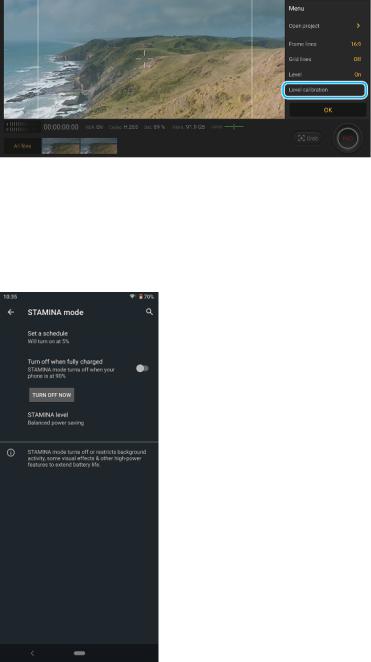
Level calibration
•You can calibrate the standard for the horizontal plane to fix deviations in the tilt direction. To calibrate the level, tap  (Menu icon) > Level calibration.
(Menu icon) > Level calibration.
Other updated features
Updated STAMINA mode
•When you turn on the STAMINA mode, the display switches to the Dark theme mode.
Ambient display settings
•The menu configur tion to access the Ambient display settings has changed. Tap
Settings > Appearance > Ambient display (Always-on display). Also, the function for displaying photos taken at your current location is no longer available.
Elimination of some functions using NFC
•One-touch portable hotspot and Android Beam (function for sharing content using the NFC function) are no longer available.
6
Internet version. For personal use only.

Xperia 5 features
Cinema Pro
Cinema Pro is an application powered by Sony's digital motion picture camera technology. You can create your ideal videos by configuring professional parameters and color settings.
To launch Cinema Pro
• Find and tap  (Cinema Pro icon).
(Cinema Pro icon).
Cinema Pro home screen
 Hint
Hint
Tap orange parameters to change settings.
1iewfinder
2Menu icon – Tap to open the menu.
•Tap Open project to open an existing project or to create a new project.
•Tap Frame lines repeatedly to display and select from various aspect ratios.
•Tap Grid lines to display and balance the composition.
3Project settings
Tap an orange parameter to adjust the ambience of the entire project or video clips. The project settings can only be changed before recording the first video clip.
4Clip settings – Parameters to adjust for each video clip. Tap Focus >  (Settings icon) to see more options for focus settings.
(Settings icon) to see more options for focus settings.
5Tap to start or stop recording.
6 Tap to capture the current frame as a still image.
7Status indications
8• Tap a thumbnail to view a video clip or still image.
•Tap All files to view a video clip or still image that is not in the thumbnail view.
•You can capture a still image from the video by tapping  (Edit video icon) while playing. Tap
(Edit video icon) while playing. Tap
 (Back button) to return to the Cinema Pro home screen.
(Back button) to return to the Cinema Pro home screen.
9Tap to change the audio level.
7
Internet version. For personal use only.

To combine clips and watch a film
1While using the Cinema Pro application, tap All files to display a list of clips in a
project.
2Tap  (More icon) > Create fin l film.
(More icon) > Create fin l film.
3Tap the clips in the order in which you want to combine them. Then, tap Create.
4To watch the created film, tap  (Navigate up button) twice, tap Final films, and then tap the film that you created.
(Navigate up button) twice, tap Final films, and then tap the film that you created.
Game enhancer
The Game enhancer application makes gameplay much more convenient with various functions. While playing a game, you can prevent notific tions from showing up, change the performance settings, and more.
Downloaded games are automatically listed in the Game enhancer application, and you can quickly launch the games from the Game enhancer menu. You can customize various settings while gaming by tapping  (Open Game enhancer menu icon).
(Open Game enhancer menu icon).
To launch the Game enhancer app
• Find and tap  (Game enhancer icon).
(Game enhancer icon).
Screen overview
8
Internet version. For personal use only.
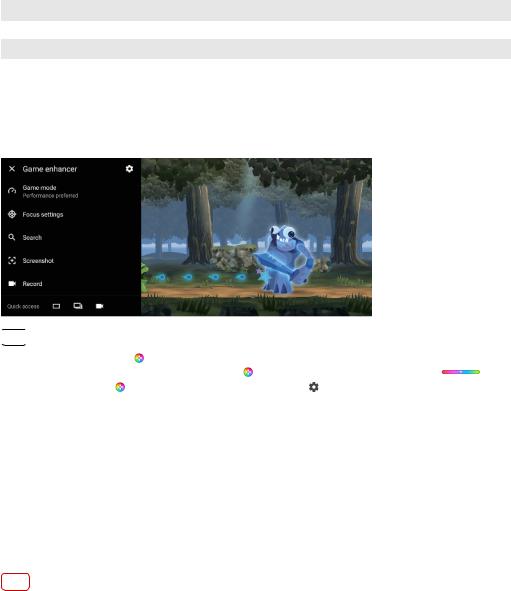
1 Add new games manually.
2Game enhancer settings
3 Recommended – Tap to launch, download or see more information about recommended games.
4Game launcher
To use Game enhancer while playing
1While playing a game, tap  (Game enhancer flo ting icon).
(Game enhancer flo ting icon).
2In the menu that opens, tap and configure the desired settings.
 Hint
Hint
|
You can drag and move (Game enhancer flo ting icon) to the desired position, such as |
|
the edge of the screen. You can also switch (Game enhancer flo ting icon) to |
|
(Pull-down bar). Tap (Game enhancer flo ting icon) > (Settings icon), and then select |
|
Pull-down bar to switch. |
|
Enhancing the sound output |
|
You can enhance the sound of your device by manually configuring the sound |
|
settings. |
|
To upgrade the quality of compressed music files |
1 |
Find and tap Settings > Sound > Audio settings. |
2 |
Enable the DSEE HX function by tapping the switch. |
|
Note |
• |
With the DSEE HX function, wired headphones that support High-Resolution Audio are |
|
needed to play back sound in near-high-resolution sound quality. |
• |
DSEE HX only works for headphones with a 3.5 mm Audio jack connected to your device |
|
with the USB host adapter. The DSEE HX function is not available for wireless or USB |
|
headphones. |
|
To enhance the sound output using Dolby Atmos® |
1 |
Find and tap Settings > Sound > Audio settings. |
2 |
Enable the Dolby Atmos function by tapping the switch. |
3Tap Dolby Atmos for more options.
Side sense
Your device has sensors on the sides that you can tap or slide with one hand in order to use your device more easily. You can display the Side sense menu as a shortcut to applications and settings, or the Multi-window menu to select two applications in the split-screen mode. You can also return to the previous screen by sliding down along the sensor. Make sure to tap or slide your finger within the sensor area. To learn more about Side sense, find and tap Settings > Display > Advanced > Side sense > TRY SIDE SENSE TUTORIAL.
9
Internet version. For personal use only.
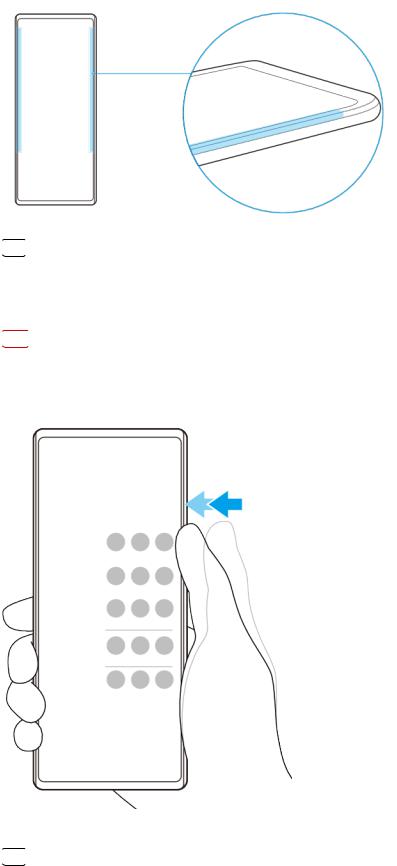
 Hint
Hint
You can change the touch position, for example, when the edge of the device is covered by a case. To change the touch position, find and tap Settings > Display > Advanced > Side sense > Configure touch position > Manual, and then tap the Operate on inner edge of screen switch.
 Note
Note
Side sense is unavailable in certain situations, such as when the screen view is in landscape orientation.
To display the Side sense menu
•To activate the Side sense menu, double-tap the side of the device.
 Hint
Hint
To exit the Side sense menu, double-tap the side of the device or tap an empty area on the screen.
10
Internet version. For personal use only.
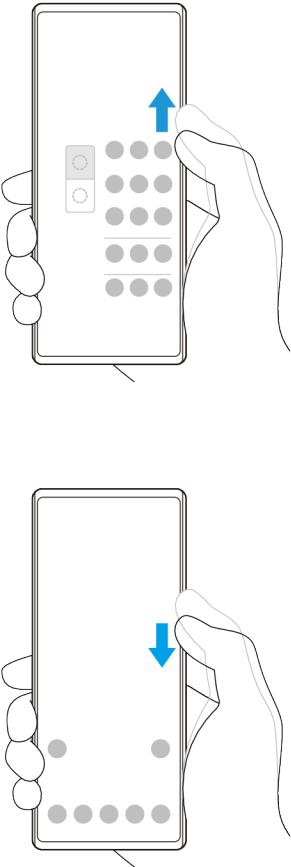
To display the Multi-window menu
1Slide your finger up along the side of the device to display the Multi-window menu.
2Follow the on-screen instructions to add apps to a split-screen.
To return to the previous screen using the side sensor
•Slide your finger down along the side of the device to return to the previous screen.
11
Internet version. For personal use only.

To turn Side sense on or off or set other Side sense options 1 Find and tap Settings > Display > Advanced.
2Tap Side sense.
3Tap the switch to enable or disable the function. To edit other Side sense options, follow the on-screen instructions in the lower part of the screen.
 Hint
Hint
For example, the following options are available for Side sense.
•Whether to use Side sense on one or both sides of your device
•The screen actions for gesture
•Whether to use Side sense on the inner edge of the screen or the side of the device
Dynamic Vibration
The Dynamic Vibration feature enhances your media experience by adding synchronized vibration when you watch videos or listen to music on your device. To learn more about this feature, go to Settings > Sound > Dynamic Vibration.
There is no vibration in the following cases:
•The media volume is set to silent.
•The screen is off.
•STAMINA mode is activated.
 Note
Note
Dynamic Vibration does not work with all media apps.
Dynamic vibration levels
Off |
No vibration |
Mild |
Less vibration |
|
|
Normal |
Well-balanced vibration |
Powerful |
More vibration |
To adjust Dynamic Vibration settings within a media app
1 Open the desired media app, for example, YouTube or the Album app.
2Start playback of the media contents.
3Press the volume key to open the volume panel.
4Drag the slider for Dynamic Vibration to set the preferred level for this app.
5The Dynamic Vibration setting is saved for the next time you use this app.
 Note
Note
There is no vibration if the media volume is set to silent.
To enable or disable Dynamic Vibration
•Find and tap Settings > Sound > Dynamic Vibration.
Ambient display settings
The ambient display lets you view information such as time, notific tions, music, or photos on the screen when the screen is turned off. The ambient display can also show album art when playing music, recently taken photos, or photos in Album taken at your current location. When you are at home, photos to be shown are selected automatically by your Xperia device.
12
Internet version. For personal use only.

To adjust the Ambient display settings
1Tap Settings > Lock screen & security > Lock screen preferences > Ambient display (Always-on display).
2 |
Tap When to show Ambient display, and then select the desired setting. |
3 |
Close the setting menu. The setting is saved. |
|
Hint |
|
The default setting is Smart activation, which activates the Ambient display when needed, |
|
for example, when walking with the device in your hand, or when taking the device out of |
|
your pocket or bag. |
|
To display an image on the Ambient display |
1 |
Tap Settings > Lock screen & security > Lock screen preferences > Ambient |
|
display (Always-on display). |
2 |
Tap Sticker, and then select your desired sticker or photo. |
3Close the setting menu. The setting is saved.
To show photos on the Ambient display
1Tap Settings > Lock screen & security > Lock screen preferences > Ambient
display (Always-on display).
2 Tap Photo playback, and then tap the switch to enable the function.
3Select Photos on device.
4Close the setting menu. The setting is saved.
Smart call handling
You can handle incoming calls without touching the screen by turning on the Smart call handling function. Once activated, you can handle calls in the following way:
•Answer: bring the device to your ear.
•Reject: shake the device.
•Ringer off place the device face down.
13
Internet version. For personal use only.
To enable or disable Smart call handling
1 Find and tap Settings > System > Gestures > Smart call handling.
2Tap the switch to enable or disable the function.
14
Internet version. For personal use only.

Getting started
About this User guide
This is the Xperia 5 User guide for the Android 9 software version. If you’re not sure which software version your device is running, you can check it in the Settings menu.
 Note
Note
System and application updates can present the features in your device in another way than described in this User guide. The Android version might not be ffected in an update. For more information about software updates, see Updating your device on page 41.
To check the current software version and model number of your device
•Find and tap Settings > System > About phone. The current software version is displayed under Build number. The current model number is displayed under Model.
Limitations to services and features
Some of the services and features described in this User guide may not be supported in all countries or regions, or by all networks or service providers. The GSM International Emergency Number can always be used in all countries, regions, networks and by all service providers, provided that the device is connected to the mobile network. Please contact your network operator or service provider to determine the availability of any specific service or feature and whether additional access or usage fees apply.
The use of certain features and applications described in this guide may require access to the internet. You may incur data connection charges when you connect to the internet with your device. Contact your wireless service provider for more information.
15
Internet version. For personal use only.

Overview
1 Ch rging/Notific tion light
2 Second microphone
3Front camera
4 Ear speaker/Second loudspeaker
5 Proximity/Light sensor
6 Volume/Zoom key
7 Fingerprint sensor
8 Power key
9Camera key
10Main loudspeaker
11USB port/Charger/Audio adapter
You can view the screen of your device on a TV or other large display device using a USB Type-C cable.
 Note
Note
When you connect your device to a TV or other large display using a USB Type-C cable, the cable must be compatible with the display port standard. Note that some functions or content on your Xperia device may not be displayable on the TV or display device.
12 Main microphone
16
Internet version. For personal use only.
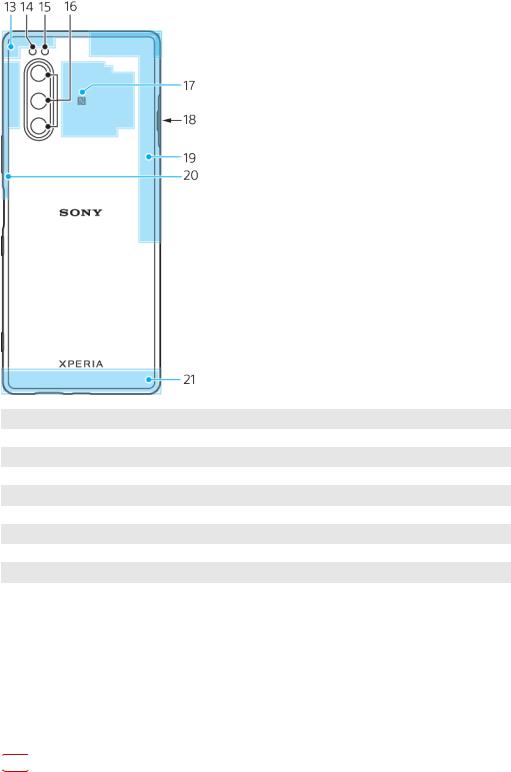
13Sub cellular antenna
14Flash LED
15RGBC IR sensor
16Main camera
17NFC detection area
18Nano SIM/Memory card slot
194th cellular/Wi-Fi/Bluetooth®/GPS antenna
203rd cellular antenna
21Main cellular antenna
Assembly - Single SIM
Your device only supports nano SIM cards. Single SIM devices allow you to use one SIM card and a memory card.
The SIM and memory cards go in different parts of the nano SIM and memory card tray. Make sure you don’t confuse the two.
For information on how to check if your device is Single SIM or Dual SIM, see
Finding the IMEI number(s) of your device on page 24.
 Note
Note
To prevent data loss, make sure you turn off your device before you drag out the tray to remove the nano SIM card or memory card from the device.
17
Internet version. For personal use only.

To insert a nano SIM card and a memory card
 Note
Note
Do not cut your SIM card, as this may damage your device.
1Drag out the SIM card tray.
2Place the SIM card securely in the SIM card tray.
3Place the memory card securely in the memory card tray.
4Gently push the SIM card tray back into the slot until it fits into place.
Assembly - Dual SIM
Your device only supports nano SIM cards. Dual SIM devices support the use of either two nano SIM cards or a nano SIM card and a memory card.
Dual SIM devices are not available in all markets or from all operators.
For information on how to check if your device is Single SIM or Dual SIM, see
Finding the IMEI number(s) of your device on page 24.
 Note
Note
To prevent data loss, make sure you turn off your device before you drag out the tray to remove the nano SIM card (or cards) or memory card from the device.
To insert either two nano SIM cards or a nano SIM card and a memory card
 Note
Note
Do not cut your SIM card, as this may damage your device.
1Drag out the SIM card tray.
2Place the main SIM card securely in position for SIM1.
3Place either the second SIM card (SIM2) or the memory card securely in the tray, in the correct orientation.
4Gently push the SIM card tray back into the slot until it fits into place.
18
Internet version. For personal use only.

Using a Dual SIM device
A Dual SIM device enables you to do the following:
• Receive incoming communications via both SIM cards.
• Select the number from which to send outgoing communications, or have the option to select a SIM card each time you place a call.
• Forward calls received via SIM 1 to SIM 2 when SIM 1 is unreachable, and vice versa. This function is called Dual SIM reachability. You must enable it manually.
Before using multiple SIM cards, you need to enable them and select a SIM card which will handle data tr ffic.
 Hint
Hint
A Dual SIM device works with either one or two SIM cards inserted.
To enable or disable the use of two SIM cards
1 Find and tap Settings > Network & internet > Advanced > Dual SIM.
2Tap the SIM 1 and SIM 2 switches to enable or disable the SIM cards.
To rename a SIM card
1 Find and tap Settings > Network & internet > Advanced > Dual SIM.
2 Select a SIM card and enter a new name for it.
3Tap OK.
To select which SIM card handles data tr ffic
1Find and tap Settings > Network & internet > Advanced > Dual SIM > Cellular data.
2Select the SIM card you want to use for data tr ffic.
|
To set the default SIM card for placing a call |
1 |
Find and tap Settings > Network & internet > Advanced > Dual SIM > Calls. |
2 |
Select an option. |
|
To enable the Dual SIM reachability function |
1 |
Find and tap Settings > Network & internet > Advanced > Dual SIM > Dual SIM |
|
reachability. |
2 |
Under Dual SIM reachability, tap the switch to enable the function. |
3Follow the on-screen instructions to complete the procedure.
 Hint
Hint
If the Dual SIM reachability function does not work after you enable it, check that you have entered the phone numbers correctly for each SIM card. In some cases, the numbers are detected automatically during setup. Otherwise, you are prompted to enter them manually.
Screen protection
 Note
Note
Before using your device, remove all protection films to enable full functionality.
Screen covers and protectors may help you protect your device against damage. We recommend you use only those screen covers intended for your Xperia device. The use of third-party screen protection accessories may prevent your device from working correctly by covering sensors, lenses, speakers, or microphones and can invalidate the warranty.
19
Internet version. For personal use only.

Starting your device for the first time
It is recommended that you charge the battery for at least 30 minutes before starting up your device for the first time. You can still use your device while it is charging. For more information on charging, see Charging your device on page 38.
The first time you start your device, a setup guide helps you to configure basic settings, personalize your device, and sign in to your accounts, for example a Google account.
To turn on your device
•Long press the power key until your device vibrates.
To turn off the device
1 Long press the power key until the options menu opens.
2 Tap Power off.
 Note
Note
It may take a while for the device to shut down.
Why do I need a Google account?
Your device from Sony runs on the Android platform developed by Google. A range of Google applications and services is available on your device when you purchase it, for example, Gmail, Google Maps, YouTube, and the Google Play application. To get the most out of these services, you need a Google account. For example, a Google account enables you to do the following:
• Download and install applications on Google Play.
• Synchronize your email, contacts, and calendar using Gmail.
• You can back up, restore and transfer your data from an old device to your new device.
• Chat with friends using the Google Duo application.
• Synchronize your browsing history and bookmarks using the Chrome web browser.
• Identify yourself as the authorized user after a software repair using Xperia Companion.
• Remotely find, lock, or clear a lost or stolen device using the Find my device services.
For more information, go to http://support.google.com/.
To set up a Google account on your device
1 Find and tap Settings > Accounts > Add account > Google.
2Follow the on-screen instructions to create a Google account, or sign in if you already have an account.
Transferring content from your old device
There are several ways to transfer your data from an old device to your new device.
•Synchronize data using Google account
•Copy and transfer data using a computer
•Copy and transfer data using an SD card
Synchronizing data using a Google account
You can transfer data by synchronizing with a Google account. First, back up your data to the Google server from your old phone using your Google account. Then,
20
Internet version. For personal use only.
set the same Google account on your new device. Depending on which contents to backup and synchronize, there are several ways.
•Gmail, Calendar, Contacts: Log in with the same Google account that you were using on your old device. Then, your Gmail, Calendar, and Contacts will be automatically synchronized with your Google account.
•Image (photo), video: Back up your data from the old device to the Google server using Google Photos. Then, synchronize with your Google account on the new device.
•Applications, setting, call history: Back up automatically using Google Drive on your old device. Then, synchronize with your Google account on your new device.
•Music and other document files Manually back up your media files from the old device using Google Drive. Then, synchronize with your Google account on the new device.
For more information, see Backing up and synchronizing with a Google account on page 46.
Transferring data using a computer
If you are storing large volumes of data on your device, you can transfer your data using a computer. For more information, see Backing up and transferring data using a computer on page 47.
Transferring data using an SD card
You can transfer media files and contacts using an SD card. For more information, see Backing up and transferring data using a memory card on page 47.
21
Internet version. For personal use only.

Device security
Making sure your device is protected
Your device includes security options, strongly recommended in case of loss or theft.
 Note
Note
When using a security option to protect your device, it is crucial to remember the details provided at set up.
Screen lock
Set a secure screen lock on your device using a PIN, password, pattern, or fingerprint to prevent others from using your device without permission. Once the screen lock is set, it is not possible to unlock the screen or erase the content via a Erase all data (factory reset) without providing the screen lock information.
Find my device
Use the Find my device service to remotely locate, lock, unlock, or erase the content on a lost device.
SIM card lock
Lock your SIM cards with a PIN to protect your subscription against misuse. The PIN is required every time you restart your device.
IMEI number
Keep a copy of the IMEI number. If your device is stolen, some network providers can use this number to stop the device from accessing the network in your country or region.
Backup
Back up the content on your device in case your device is damaged, lost or stolen.
•To back up with a Google account, see Backing up and synchronizing with a Google account on page 46.
•To back up using a computer, see Backing up and transferring data using a computer on page 47.
•To back up using a memory card, see Backing up and transferring data using a memory card on page 47.
Screen lock
When the screen is locked you have to unlock it with a swipe gesture or with your personal pattern, PIN, password or fingerprint. Initially, the unprotected screen swipe is set, but it is recommended to use a more secure screen lock to protect your device.
The security level of each lock type is listed below in order of weakest to strongest:
•Swipe: no protection, but you have quick access to the Home screen.
•Pattern: draw a simple pattern with your finger to unlock your device.
•PIN: enter a numeric PIN of at least four digits to unlock your device.
•Password: enter an alpha-numeric password to unlock your device.
22
Internet version. For personal use only.

• Fingerprint: place your registered finger on the sensor to unlock your device.
 Hint
Hint
The Smart Lock feature lets you set your device to unlock automatically in certain situations, such as when connected to a Bluetooth device or carrying your device with you. For more information, go to http://www.support.google.com/.
To create or change a screen lock
 Note
Note
It is very important that you remember your screen lock when using a pattern, PIN or password. If you forget this information, it may not be possible to restore important data such as contacts and messages.
1 Find and tap Settings > Lock screen & security > Screen lock.
2If requested, confirm your current screen lock.
3Choose an option and follow the on-screen instructions.
4When you are finished, press the power key to lock the screen.
Fingerprint Manager
Register your fingerprint to use it as an additional security method for unlocking your device or authenticating purchases. You can register up to 5 fingerprints on your device.
The pattern, PIN, or password screen lock serves as a backup unlock method when a fingerprint is used as a screen lock. Before registering your fingerprint, make sure the sensor is clean and without any visible moisture.
To register a fingerprint
1Find and tap Settings > Lock screen & security > Fingerprint Manager.
2Tap Next and follow the on-screen instructions to complete fingerprint registration.
3You can add, delete, or rename a fingerprint. Edit the options as desired.
SIM card protection
You can lock and unlock each SIM card that you use in your device with a PIN. When a SIM card is locked, the subscription linked to the card is protected against misuse, meaning that you have to enter a PIN every time you start your device.
If you enter the PIN incorrectly too many times, your SIM card will get blocked. You then need to enter your PUK (Personal Unblocking Key) and a new PIN. Your PIN and PUK are supplied by your network operator.
To set up a SIM card lock
1 Find and tap Settings > Lock screen & security > Advanced > SIM card lock.
2Dual SIM users, select a SIM card.
3Tap the Lock SIM card switch to enable.
4Enter the SIM card PIN and tap OK. The SIM card lock is now active and you will be prompted to enter your PIN every time you restart your device.
To change the SIM card PIN
1 Find and tap Settings > Lock screen & security > Advanced > SIM card lock.
2Dual SIM users, select a SIM card.
3Tap Change SIM PIN and follow the on-screen instructions.
23
Internet version. For personal use only.
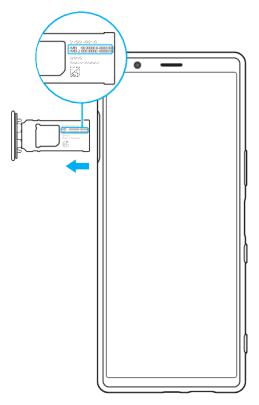
Finding the IMEI number(s) of your device
Your device has one or two unique identific tion numbers that are referred to as IMEI or Product ID. You should keep a copy of this. You may require it if your device is stolen or when contacting support.
To view your IMEI number(s) using the dialpad 1 Find and tap  (Phone icon).
(Phone icon).
2Tap  (Dialpad icon).
(Dialpad icon).
3Enter *#06# into the dialpad. The IMEI number(s) are displayed automatically.
To view your IMEI number(s) on the back of the tray
•Drag out the SIM card tray. The IMEI number(s) is(are) displayed on the back of the tray.
Finding, locking or erasing a lost device
Google offers a location and security web service called Find my device. After you have signed in to a Google account, Find my device is turned on by default. If you lose your device, you can use Find my device to:
•Find and show where your device is located on a map.
•Lock your device and present a message on the lock screen.
•Erase data from your device.
•Activate the ringer, even if the sound is turned off.
Your device must be turned on, have an internet connection, and have the location service activated. The Find my device service may not be available in all countries or regions.
For more information, go to https://support.google.com/.
24
Internet version. For personal use only.
To verify that your device can be found
•Go to https //www.google.com/ ndroid/find and sign in using your Google account.
25
Internet version. For personal use only.

Learning the basics
Using the touchscreen
Tapping
•Open or select an item.
•Mark or unmark a checkbox or option.
•Enter text using the on-screen keyboard.
Touching and holding
•Move an item.
•Activate selection mode, for example, to select several items from a list.
26
Internet version. For personal use only.

Pinching in and out
•Pinch in and out on web pages, photos and maps, and when you’re taking photos or shooting videos.
Swiping and scrolling
•Scroll up and down, or left and right.
•Swipe left or right, for example, between Home screen panes.
Turning the screen on or off
When your device is on and left idle for a set period of time, the screen dims and turns off to save battery power. You can change how long your screen stays active before it turns off.
27
Internet version. For personal use only.

When your screen is turned off, your device can be locked or unlocked, depending on your screen lock setting. See Screen lock on page 22.
The Ambient display feature enables you to view information such as the time and notific tions without pressing the power key.
To turn the screen on or off
• Briefly press the power key.
 Hint
Hint
If the ambient display is set to Smart activation or Show when device is lifted, the screen is turned on automatically when you pick up your device. See Ambient display settings on page 12.
To adjust the idle time before the screen turns off 1 Find and tap Settings > Display > Sleep.
2Select an option.
Smart backlight control
The smart backlight control keeps the screen on as long as the device is held in your hand. Once you put down the device, the screen turns off according to your sleep setting.
To enable or disable the Smart backlight control function
1 Find and tap Settings > Display > Advanced > Smart backlight control.
2Tap the switch to enable or disable the function.
Home screen
The Home screen is the starting point for using your device. You can adjust the Home screen settings, such as changing the wallpapers.
 Note
Note
Avoid displaying very bright or static images for a long period of time. This may cause an afterimage or coloring to remain on the screen.
To go to the Home screen
• Tap  (Home button).
(Home button).
To adjust the Home screen settings
1 Touch and hold an empty area on your Home screen until the device vibrates. Icons for the Home screen settings appear.
2Tap to edit the settings as desired.
Application screen
You can open or search for applications from the Application screen.
28
Internet version. For personal use only.
